New products at Crocus
by Sarah - May 27th, 2009.Filed under: Crocus, New Products.
New lines today at Crocus
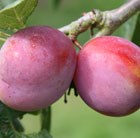
plum £29.99
Position: full sunSoil: will tolerate most soils, except very chalky or badly drainedRate of growth: slow growingUltimate size (Pixy): 3x3m (10x10ft)Ultimate size (St Julian): 3.75×3.75m (13x13ft)Flowering period: April to MayFlower colour: whiteOther features: top quality culinary or dessert plum (late September)Hardiness: fully hardyA reliable, self-fertile plum which produces a heavy crop of large, pale red fruit with golden-yellow flesh, which can be used for cooking, canning, bottling or just eating fresh. The single, white flowers are produced in spring and fruiting picking can start in late August. It is one of the most popular plum trees available but does need the fruit to be thinned to avoid biennial fruiting.Garden care: When planting incorporate lots of well-rotted garden compost in the planting hole and stake firmly. Prune in summer to reduce the risk of silver leaf and bacterial canker.

burgon-&-ball-topiary-hedge-shears £24.99
When faced with large scale topiary (or Buxus), hedge trimming where less precision is required, then a pair of two handed shears will enable the job to be completed more quickly.These super-lightweight 750g, aluminium handled topiary hedge shears feature highly pointed blades with racing green rubber grips and cushion stops to reduce jarring.SizeBlade length 18cm.Overall length 59cm
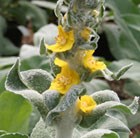
mullein £9.99
Position: full sunSoil: poor, well-drained, alkaline soilRate of growth: average Flowering period: July to August Flower colour: butter yellowHardiness: fully hardyAn attractive rosette-forming biennial that is covered in silky silver hairs. In summer tall spikes of saucer-shaped, butter yellow flowers appear above white-wholly basal leaves. A stunning plant for the back of a sunny border or planted in dramatic swathes in an island bed.Garden care: Mullein moth caterpillars can be a problem, so look out for them in early June and pick them off as soon as they appear. Remove faded flower-spikes. Apply a thick 5-7cm (2-3in) mulch around the base of the plant in early springIt is worth keeping in mind that these plants are mainly biennial, so although they usually self-seed freely, the plant will only live for two years

intermediate bearded iris £7.99
Position: full sunSoil: well-drained, moderately fertile soilRate of growth: averageFlowering period: May to JuneHardiness: fully hardyAn award-winning iris which has dark magenta flowering with deep purple veining on the petals and unusual brown beards. This is an extraordinarily free flowering variety and makes a real impact planted in bold swathes in a sunny border.Garden care: Bearded irises prefer full sun and neutral-alkaline soil but if you have acidic or peaty soils you can top dress with lime before planting for good results. Plant shallowly with the upper part of the rhizome sitting on the surface of the soil, incorporating a low nitrogen fertiliser in the planting hole. After planting remove the upper-most third of the leaves to protect against wind-rock. In exposed areas stake with bamboo canes in early spring. Divide and replant about every three years.
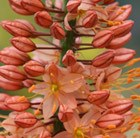
foxtail lily £7.49
Position: full sunSoil: fertile, sandy, well-drained soil, including alkaline soilRate of growth: fastFlowering period: June and JulyHardiness: fully hardyStately, slender spikes packed with burnt orange flowers soar above strap shaped, bluish-green leaves in early and mid summer. This spectacular foxtail lily makes a bold statement towards the back of a sunny, well-drained border. It's best partnered with late-flowering perennials and tall grasses which help to mask the plant's short lived foliage.Foxtail lilies need to be planted in fertile but well-drained soil with the crown not far below soil level. They start to grow in late winter and spring, gathering their strength before they produce their towering flower spikes in summer. Each flower spike has hundres of flowers which open from the bottom upwards, creating a stunning effect. They thrive in the sunniest spot in the garden, especially if the base of the plant isn't shaded as this can decrease the number of flowering spikes produced. Garden care: In September every three to five years carefully lift and divide congested clumps. Replant the strongest crown on a layer of sharp grit, spreading out the roots and covering them with a thin (5cm/2in) layer of soil. In frost-prone areas cover with a dry mulch of fern leaves.

masterwort £6.99
Position: full sun or partial shadeSoil: fertile, moist, preferably humus-rich soilRate of Growth: fast-growingFlowering period: June to SeptemberFlowers: soft pinkOther features: excellent cut and dried flowersHardiness: fully hardyDelicate, papery, soft pink flowers which are held on wiry stems above attractive deeply lobed, mid-green leaves. This delightful masterwort is a vigorous variety with a much longer flowering period than most pink or red varieties. It looks particularly fetching planted with grasses and is garden designer, Piet Oudolf's favourite masterwort.Astrantias have been cultivated in Britain since the 16th century and have numerous common names, such as melancholy gentleman, Hattie's pincushion and the more well known masterwort. Garden care: Incorporate plenty of organic matter when planting and water well in dry weather especially newly established plants. Lift and divide large clumps in early spring and apply a generous 5-7 cm mulch of well-rotted manure or garden compost around the plant. Divided specimens may take some time to establish since they don't like having their roots disturbed.
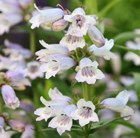
beard tongue £5.99
Position: full sun or partial shadeSoil: fertile, well-drained soilRate of growth: average Flowering period: July to OctoberHardiness: fully hardy (borderline)Vivid, almost luminous, lilac flowers are produced on tall stems among lance-shaped, bright green leaves. The flowers are tubular, rather like foxgloves, and if you deadhead regularly, they will persist until the first frosts. This pretty, easy-to-grow perennial will quickly form large, leafy clumps and is perfect for adding a splash of colour to the middle of a sunny, well-drained border.Garden care: Remove the faded blooms regularly to prolong flowering. Apply a dry mulch around the base of the plant to protect the roots from frost damage and cut back in spring when new shoots appear low down on the stem. Lift and divide congested clumps in spring.

Balkan clary £4.99
Position: full sunSoil: light, moderately fertile, humus-rich, moist but well- drained soilRate of growth: average Flowering period: June to October Flower colour: violet-blueOther features: attractive to butterflies and beesHardiness: fully hardyGlowing purple stems loaded with violet-blue flowers from June to October. The grey-green, aromatic foliage also makes an attractive accent in the summer border. A compact variety that is perfect for adding a splash of colour at the front of a well- drained herbaceous border or gravel garden. Coping well in sun, the blooms are a magnet for butterflies and bees.Garden care: To prolong flowering remove the flower spikes as soon they start to fade. Apply a generous 5-7cm (2-3in) mulch of well-rotted garden compost or manure around the base of the plant in spring.
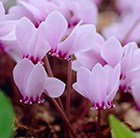
sowbread £4.99
Position: full sun to partial shadeSoil: humus-rich, well-drained soilRate of growth: averageFlowering period: October to JanuaryHardiness: fully hardyWith their pretty, marbled, heart-shaped leaves and upright, fragrant pinkor white flowers, these cyclamen have a long season of interestbefore disappearing below ground over the summer. The flowers of thisautumn-flowering cyclamen often appear well before the leaves, which form a pretty carpet after the flowers have finished. Although they areusually planted in shade, these cyclamen originate from the Mediterranean, soare equally happy in sun. Plant them en masse in a woodland setting with ferns and other shade-tolerant plants or around the base ofdeciduous trees.Garden care: Plant shallowly in humus-rich, fertile soil. Apply a mulch of well-rotted leafmould around the crown of the plants in spring as the foliage starts to die back.
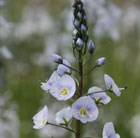
speedwell £3.99
Position: full sun or partial shadeSoil: moderately fertile, moist, well-drained soilRate of growth: averageFlowering period: May and JuneFlower colour: blueHardiness: fully hardySpires of cup shaped, clear blue flowers in May and June above robust rosettes of dark green leaves. This delicate speedwell looks lovely towards the front of a mixed or herbaceous border in sun or partial shade. One of the first speedwells to flower, it thrives in fertile, moist, well-drained soil. Garden care: Remove faded flower-stems in autumn. Apply a generous 5-7cm mulch of well-rotted garden compost or manure around the base of the plant in spring.






